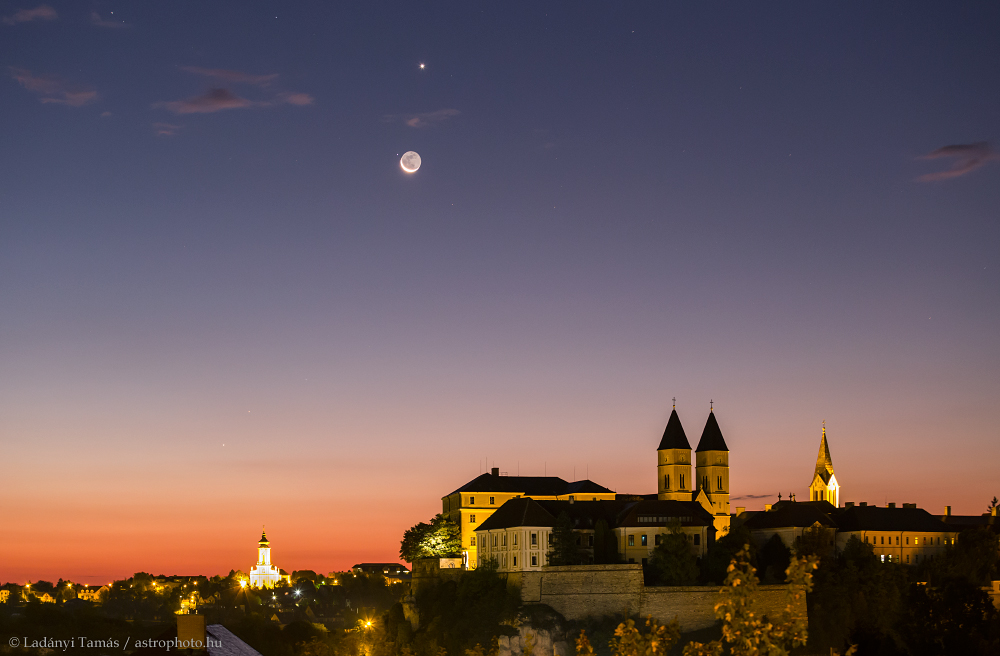Fonte na rua Serpa Pinto
2017-09-30
Astronomy picture of the day - 2017 September 30 - Portrait of NGC 281
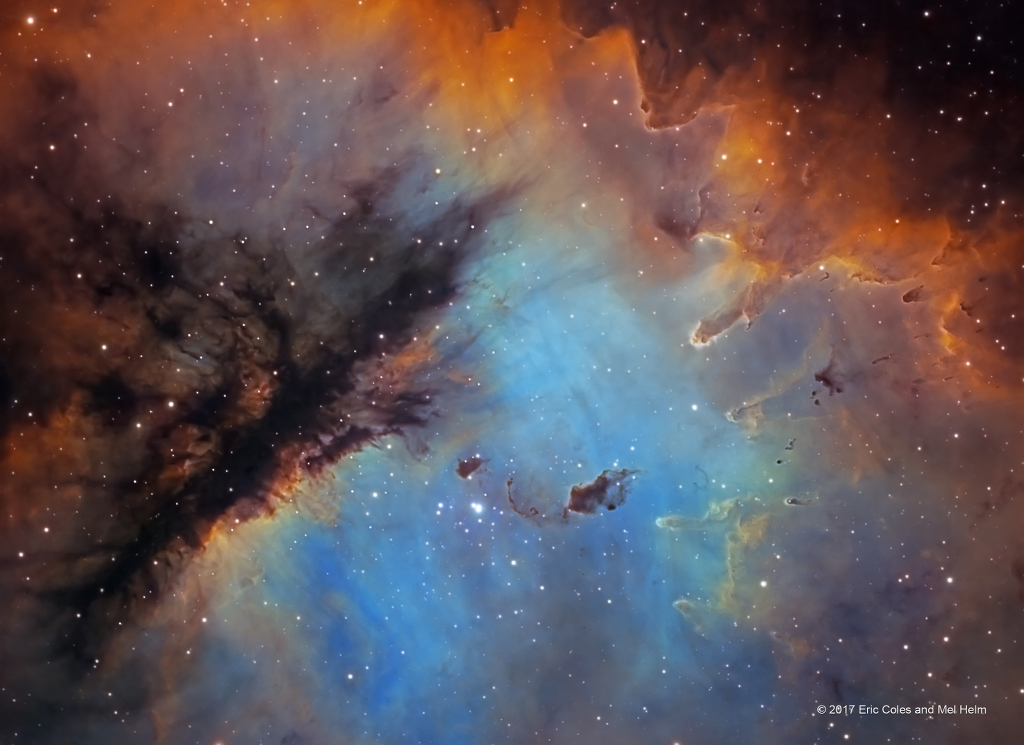
Image Credit & Copyright: Eric Coles and Mel Helm
Explanation: Look through the cosmic cloud cataloged as NGC 281 and you might miss the stars of open cluster IC 1590. Still, formed within the nebula that cluster's young, massive stars ultimately power the pervasive nebular glow. The eye-catching shapes looming in this portrait of NGC 281 are sculpted columns and dense dust globules seen in silhouette, eroded by intense, energetic winds and radiation from the hot cluster stars. If they survive long enough, the dusty structures could also be sites of future star formation. Playfully called the Pacman Nebula because of its overall shape, NGC 281 is about 10,000 light-years away in the constellation Cassiopeia. This sharp composite image was made through narrow-band filters, combining emission from the nebula's hydrogen, sulfur, and oxygen atoms in green, red, and blue hues. It spans over 80 light-years at the estimated distance of NGC 281.
2017-09-28
Astronomy picture of the day - 2017 September 28 - LIGO-Virgo GW170814 Skymap
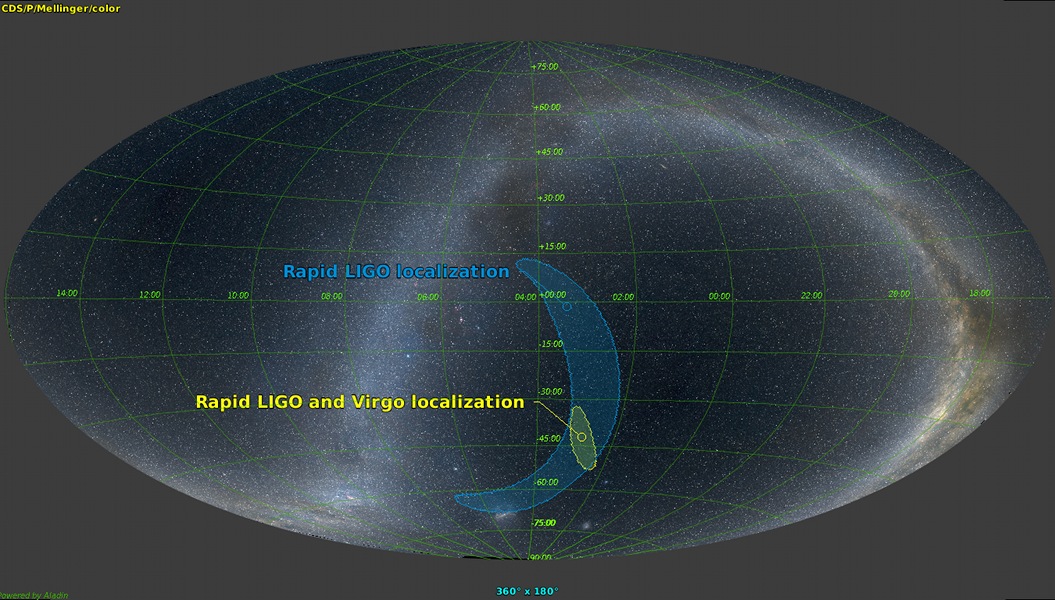
Illustration Credit: LIGO- Virgo Collaboration - Optical Sky Data: A. Mellinger
Explanation: From around planet Earth three gravitational wave detectors have now reported a joint detection of ripples in spacetime, the fourth announced detection of a binary black hole merger in the distant Universe. The eventwas recorded on 2017 August 14, and so christened GW170814, by the LIGO observatory sites in Hanford, Washington and Livingston, Louisiana, and the more recently operational Virgo Observatory near Pisa, Italy. The signal was emitted in the final moments of the coalescence of two black holes of 31 and 25 solar masses located about 1.8 billion light-years away. But comparing the timing of the gravitational wave detections at all three sites allowed astronomers to vastly improve the location of the signal's origin on the sky. Just above the Magellanic clouds and generally toward the constellation Eridanus, the only sky region consistent with signals in all three detectors is indicated by the yellow contour line in this all-sky map. The all-sky projection includes the arc of our Milky Way Galaxy. An improved three-detector location of the gravitational wave source allowed rapid follow-up observations by other, more conventional, electromagnetic wave observatories that can search for potentially related signals. The addition of the Virgo detector also allowed the gravitational wave polarization to be measured, a property that further confirms predictions ofEinstein's general relativity.
2017-09-27
FC Porto venceu em casa do Mónaco por 3-0

FC Porto venceu em casa do Mónaco por 3-0 na segunda jornada da fase de grupos da Liga dos Campeões. Imprensa internacional com fortes elogios.
Mónaco curvou-se
"A equipa de Leonardo Jardim curvou-se perante um FC Porto melhor organizado a todos os níveis. Aboubakar, possante como de costume, destruiu a defesa do Mónaco e resolveu o jogo" .
L'Equipe, França
Poder físico do FC Porto
"O Mónaco não conseguiu conter o poderio físico do FC Porto e teve dificuldades para entrar num bloco defensivo muito sólido. O segundo golo, construído por Brahimi e Marega, foi muito bom".
France Football, França
Tigre metido na jaula
"Os dragões conseguiram apagar o máximo goleador das grandes Ligas europeias, Falcao. El Tigre não foi capaz de rugir, de sacar das unhas, nem sequer de morder. Um FC Porto organizado venceu".
Marca, Espanha
O principado é mexicano
"Com os quatro mexicanos em campo, o FC Porto sacou um triunfo valioso no Mónaco e voltam a estar na luta pelos oitavos de final. Laýun fez o terceiro e cobriu de glória o triunfo dos dragões".
Récord, México
FC Porto surpreende
"O FC Porto está vivo na Liga dos Campeões! Os portugueses foram ao Mónaco enfrentar o campeão francês e, apesar do favoritismo dos donos da casa, venceram com autoridade".
Lancenet, Brasil
Astronomy picture of the day - 2017 September 27 - Layers of a Total Solar Eclipse
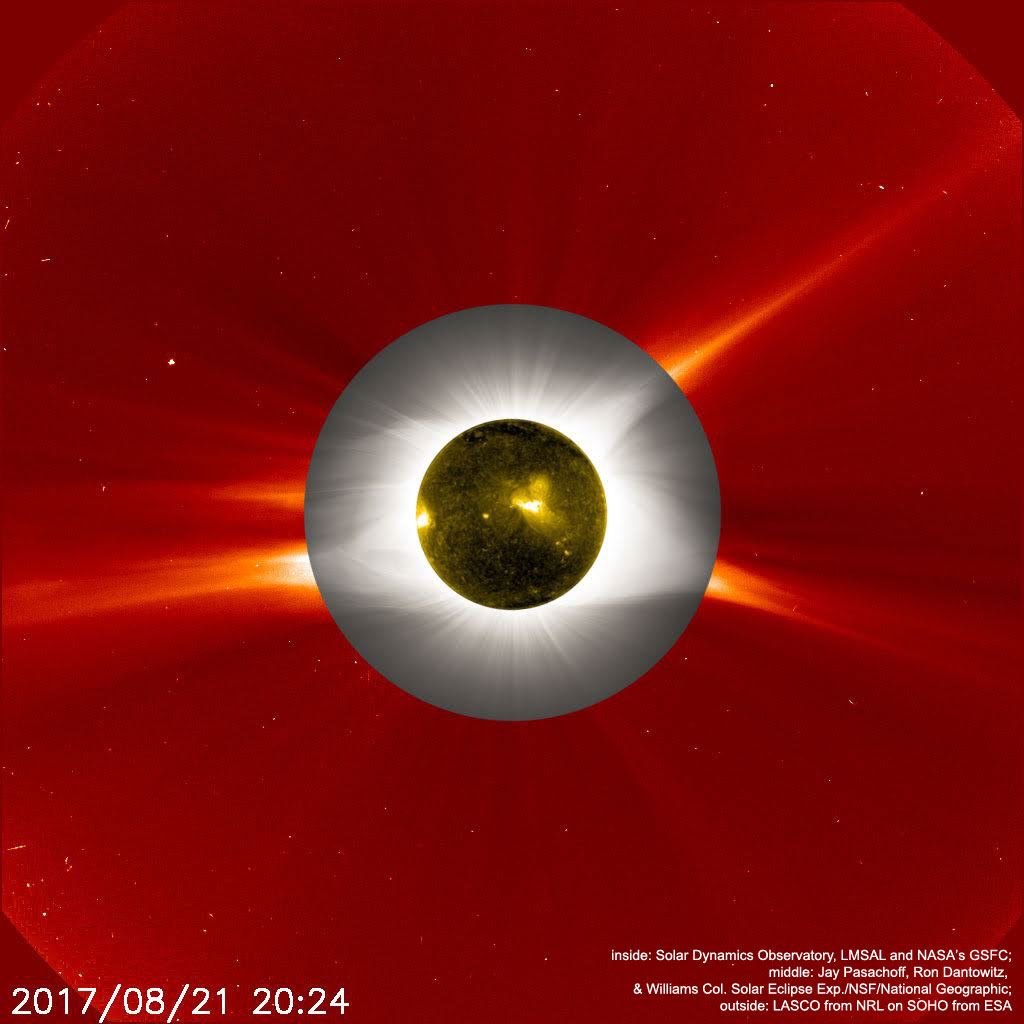
Image Credit: Inside: Solar Dynamics Observatory, LMSAL and NASA’s GSFC;
Middle: Jay Pasachoff, Ron Dantowitz, and the Williams College Solar Eclipse Expedition/NSF/National Geographic;
Outside: LASCO from NRL on SOHO from ESA
Explanation: Neither rain, nor snow, nor dark of night can keep a space-based spacecraft from watching the Sun. In fact, from its vantage point 1.5 million kilometers sunward of planet Earth, NASA's SOlar Heliospheric Observatory(SOHO) can always monitor the Sun's outer atmosphere, or corona. But only during a total solar eclipse can Earth-based observers also see the lovely coronal streamers and structures - when the Moon briefly blocks the overwhelmingly bright solar surface. Then, it becomes possible to follow detailed coronal activity all the way down to the Sun's surface. In the outside layer of this composite image, SOHO's uninterrupted view of the solar corona duringlast month's eclipse is shown in orange hues. The middle, donut-shaped region is the corona as recorded by the Williams College Eclipse Expedition to Salem, Oregon. Simultaneously, the inner view is from NASA's Earth-orbitingSolar Dynamics Observatory, which, being outside of totality, was able to image the face of the Sun in extreme ultraviolet light, shown in gold.
2017-09-26
Imagens do Mundo - Trabalhador retira cabos elétricos numa rua de Banguecoque, Tailândia.

Trabalhador retira cabos elétricos numa rua de Banguecoque, Tailândia.
DIEGO AZUBEL EFE
Imagens do Mundo - Policia militar na favela da Rocinha - Rio de Janeiro, Brasil

"Favela da Rocinha, Rio de Janeiro"
Imagens do Mundo - Funâmbulo em Praga

Funâmbulo em equilíbrio na corda bamba na praça da cidade
velha de Praga (República Checa).
MARTIN DIVISEK EFE
Imagens do Mundo - Vulcão Agung, Indonésia

Homem observa o vulcão Agung, coberto de nuvens, desde um templo de Karangasem (Indonesia).
FIRDIA LISNAWATI AP
Astronomy picture of the day - 2017 September 26 - Cassini's Last Ring Portrait at Saturn
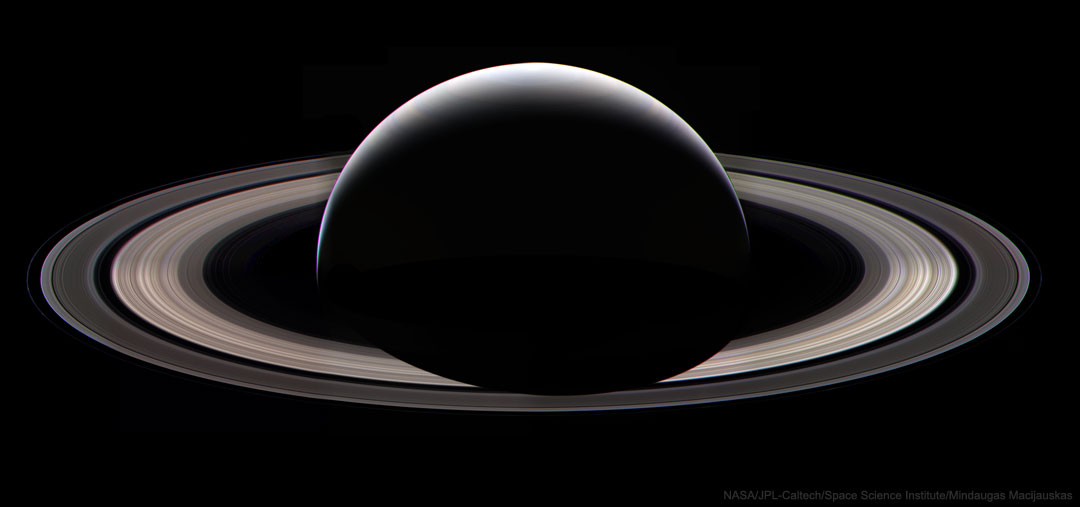
Image Credit: NASA, JPL-Caltech, Space Science Institute, Mindaugas Macijauskas
Explanation: How should Cassini say farewell to Saturn? Three days before plunging into Saturn's sunny side, the robotic Cassini spacecraft swooped far behind Saturn's night side with cameras blazing. Thirty-six of these images have been merged -- by an alert and adept citizen scientist -- into a last full-ring portrait of Cassini's home planet for the past 13 years. The Sun is just above the frame, causing Saturn to cast a dark shadow onto its enormous rings. This shadow position cannot be imaged from Earth and will not be visible again until another Earth-launched spaceship visits the ringed giant. Data and images from Cassini's mission-ending dive into Saturn's atmosphere on September 15 continue to be analyzed.
2017-09-25
Imagens do Mundo - Festival Durga Puja - Calcuta, India

Um artesão pinta uuma escultura, antes do começo do festival Durga Puja, em Calcuta (India).
RUPAK DE CHOWDHURI REUTERS
Astronomy picture of the day - 2017 September 25 - Massive Shell-Expelling Star G79.29+0.46
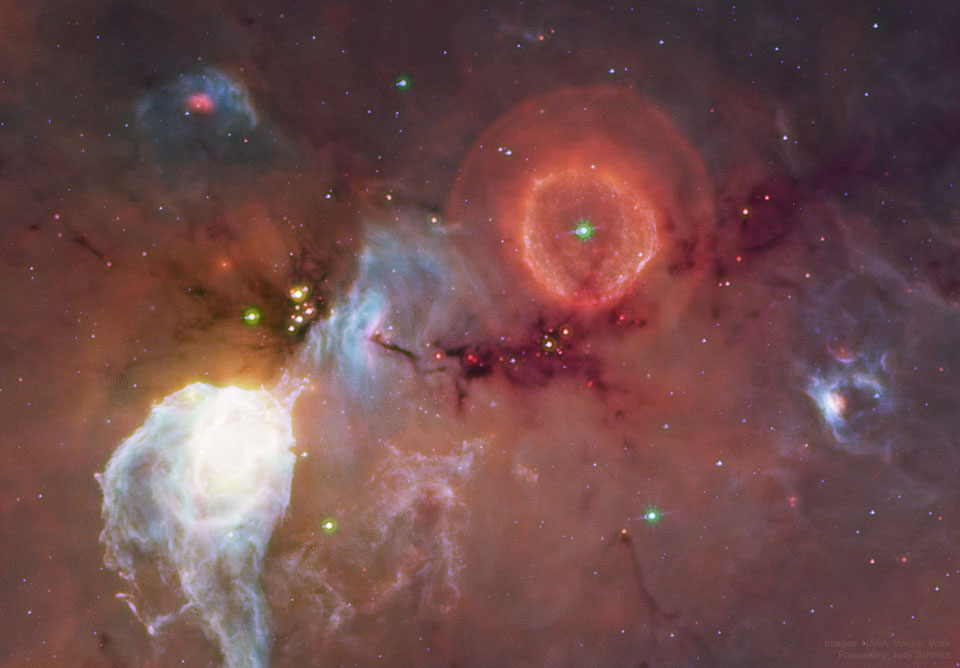
Image Credit: NASA, Spitzer Space Telescope, WISE; Processing & License : Judy Schmidt
Explanation: Stars this volatile are quite rare. Captured in the midst of dust clouds and visible to the right and above center is massive G79.29+0.46, one of less than 100 luminous blue variable stars (LBVs) currently known in our Galaxy. LBVs expel shells of gas and may lose even the mass of Jupiter over 100 years. The star, itself bright and blue, is shrouded in dust and so not seen in visible light. The dying star appears green and surrounded by red shells, though, in this mapped-color infrared picture combining images from NASA's Spitzer Space Observatory and NASA's Wide-Field Infrared Survey Explorer. G79.29+0.46 is located in the star-forming Cygnus X region of our Galaxy. Why G79.29+0.46 is so volatile, how long it will remain in the LBV phase, and when it will explode in a supernova is not known.
2017-09-24
Astronomy picture of the day - 2017 September 24 - How to Identify that Light in the Sky
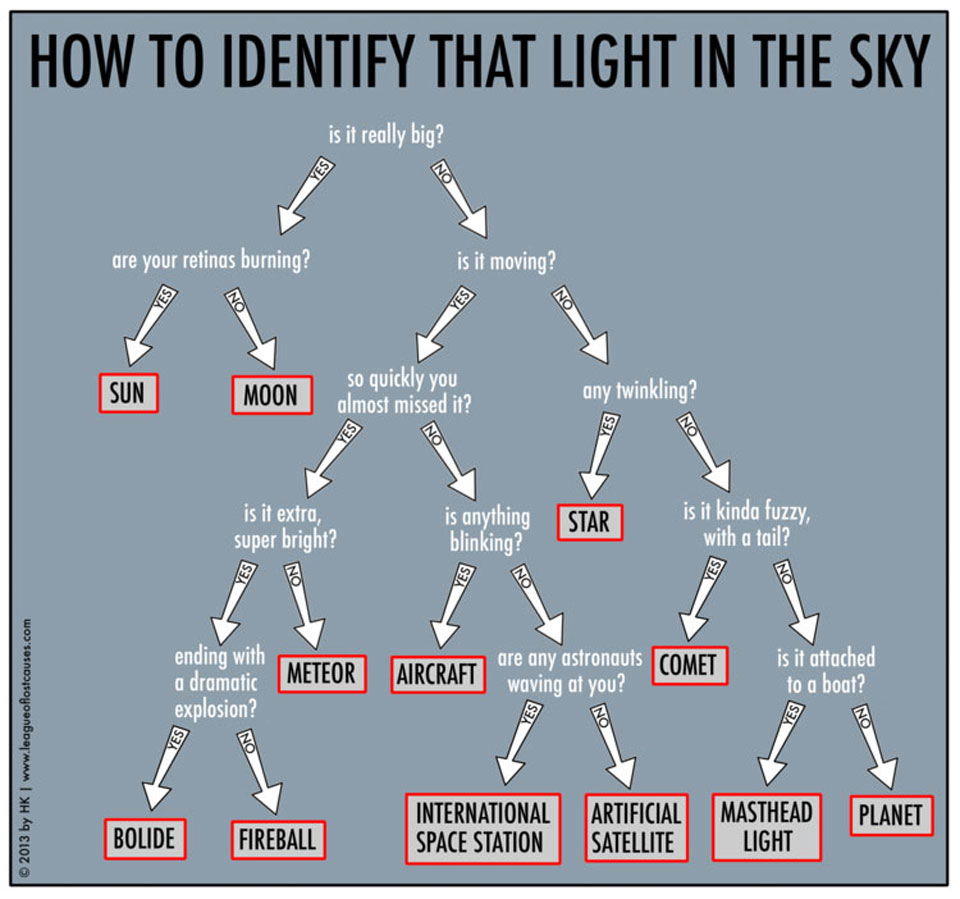
Image Credit & Copyright: HK (The League of Lost Causes)
Explanation: What is that light in the sky? Perhaps one of humanity's more common questions, an answer may result from a few quick observations. For example -- is it moving or blinking? If so, and if you live near a city, the answer is typically an airplane, since planes are so numerous and so few stars and satellites are bright enough to be seen over the din of artificial city lights. If not, and if you live far from a city, that bright light is likely a planet such as Venus orMars -- the former of which is constrained to appear near the horizon just before dawn or after dusk. Sometimes the low apparent motion of a distant airplane near the horizon makes it hard to tell from a bright planet, but even this can usually be discerned by the plane's motion over a few minutes. Still unsure? The featured chart gives a sometimes-humorous but mostly-accurate assessment. Dedicated sky enthusiasts will likely note -- and are encouraged to provide -- polite corrections.
2017-09-23
Astronomy picture of the day - 2017 September 20 - The Big Corona
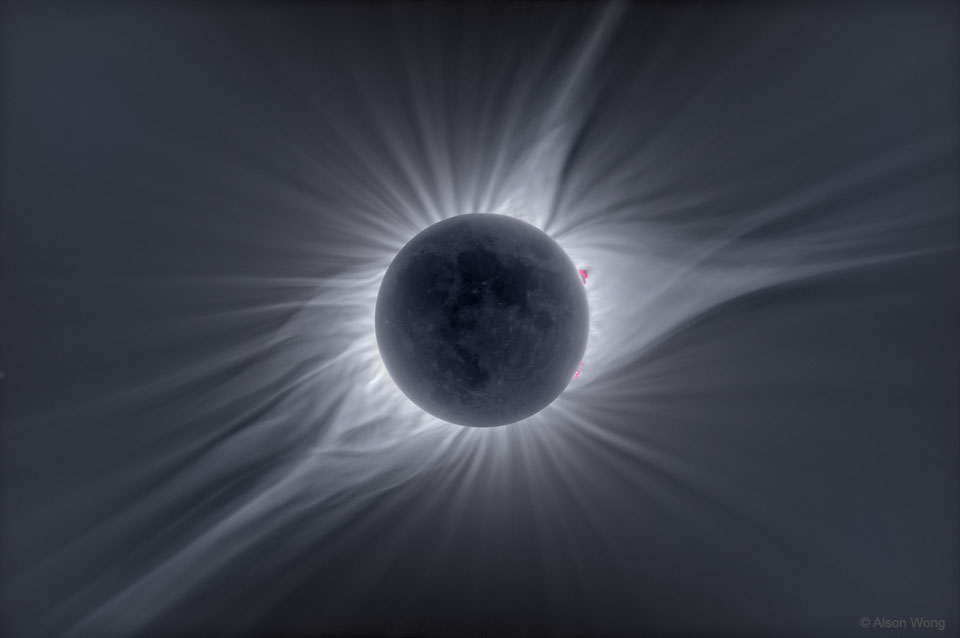
Image Credit & Copyright: Alson Wong
Explanation: Most photographs don't adequately portray the magnificence of the Sun's corona. Seeing the corona first-hand during a total solar eclipse is unparalleled. The human eye can adapt to see coronal features and extent that average cameras usually cannot. Welcome, however, to the digital age. The featured picture is a combination of forty exposures from one thousandth of a second to two seconds that, together, were digitally combined and processed to highlight faint features of the total solar eclipse that occurred in August of 2017. Clearly visible are intricate layers and glowing caustics of an ever changing mixture of hot gas and magnetic fields in the Sun's corona. Looping prominencesappear bright pink just past the Sun's limb. Faint details on the night side of the New Moon can even be made out, illuminated by sunlight reflected from the dayside of the Full Earth.
2017-09-22
Sitios lindos de Portugal - Albufeira da barragem de Vilarinho das Furnas
Albufeira da Barragem de Vilarinho das Furnas
Vilarinho da Furna (normalmente chamada de Vilarinho das Furnas) era uma aldeia situada no concelho de Terras de Bouro, no distrito de Braga. Com a construção da barragem de Vilarinho das Furnas em 1971 a aldeia ficou submersa, mas em anos de seca extrema, com o nível da albufeira baixo, é possível ainda ver os restos da aldeia. A Albufeira da Barragem de Vilarinho das Furnas cobre 77 km2 e é cercada de uma beleza natural que torna o lugar óptimo para desfrutar da natureza e de actividades ao ar-livre.
Autor : João Leitão
Astronomy picture of the day - 2017 September 22 - Solar Eclipse Solargraph
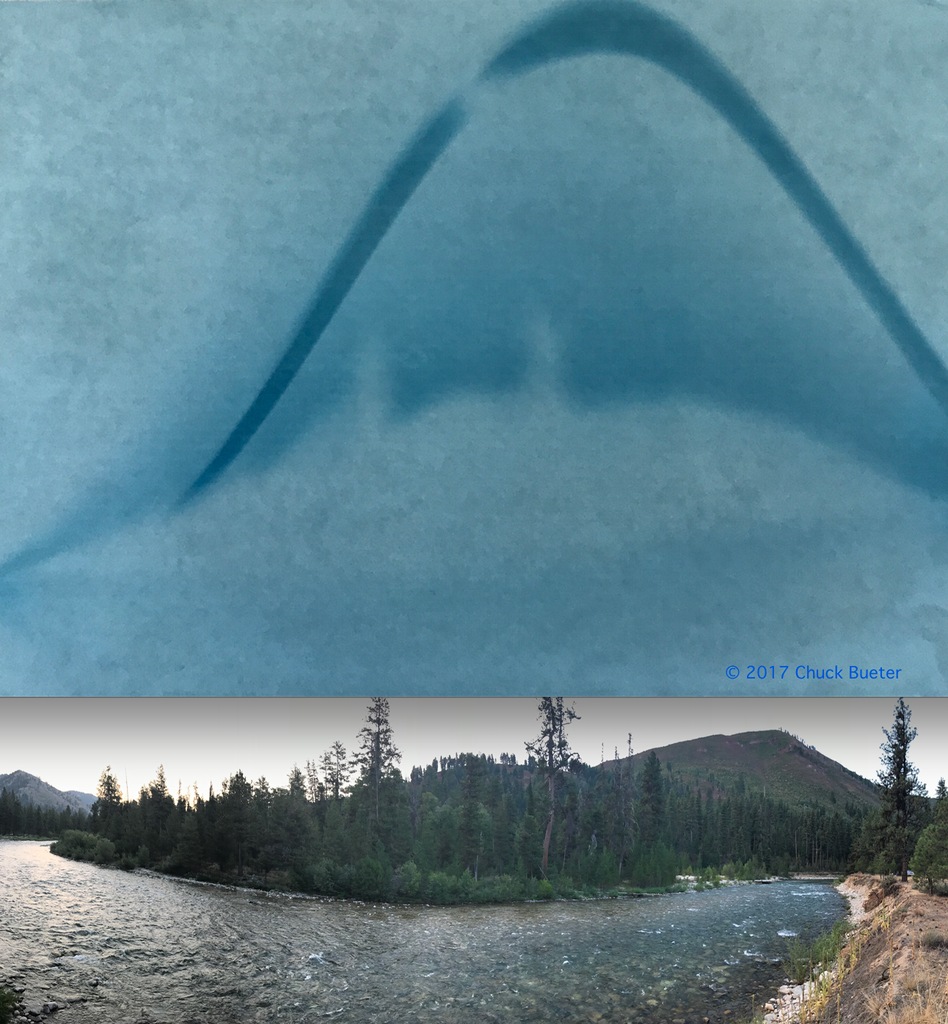
Image Credit & Copyright: Chuck Bueter (Nightwise.org)
Explanation: Today is the September equinox. Heading south, the Sun's path through the sky will cross the celestial equator at 20:02 UT. Of course the equinox date results in (mostly) equal night and day all over planet Earth. But on August 21 the Sun's path through the sky found a little extra-night for some. Made with a drink can pinhole camera and light-sensitive paper, this creative solargraph follows the Sun's path on that date. An all-day exposure, it traces the Sun's arc still rising high in northern skies, aligned with a panoramic snapshot of the local landscape at the bottom. The gap in the arc represents the duration of the partial and total phases of the solar eclipse in clear skies over Lowman, Idaho, USA. There, the extra-night (totality) lasted for about 2 minutes. The broad gap in the Sun's arc also covers the loss of sunlight during the more extended partial eclipse phases.
2017-09-21
Imagens do Mundo - Lua e Castelo de S. Jorge (Portugal)

A lua ilumina o Castelo de São Jorge. Lisboa, Portugal.
ARMANDO FRANCA AP
Imagens do Mundo - Vista de uma praia em Alexandria (Egipto)

Vista de uma praia em Alexandria (Egipto).
MOHAMED HOSSAM EFE
Imagens do Mundo - Hong Kong, China

Um ferry navega até à Ilha de Hong Kong, China.
ANTHONY WALLACE AFP
Astronomy picture of the day - 2017 September 21 - A September Morning Sky
Image Credit & Copyright: Tamas Ladanyi (TWAN)
Explanation: The Moon, three planets, and a bright star gathered near the ecliptic plane in the September 18 morning sky over Veszprem Castle, Hungary. In this twilight skyscape, Mercury and Mars still shine close to the eastern horizon, soon to disappear in the glare of the Sun. Regulus, alpha star of the constellation Leo, is the bright point next to a waning crescent Moon, with brilliant Venus near the top of the frame. The beautiful morning conjunction of Moon, planets, and bright star could generally be followed by early morning risers all around planet Earth. But remarkably, the Moon also occulted, or passed directly in front of, Regulus and each of the three planets within 24 hours, all on September 18 UT. Visible from different locations, timing and watching the lunar occultations was much more difficult though, and mostly required viewing in daytime skies.
2017-09-19
Astronomy picture of the day - 2017 September 19 - Veil Nebula: Wisps of an Exploded Star
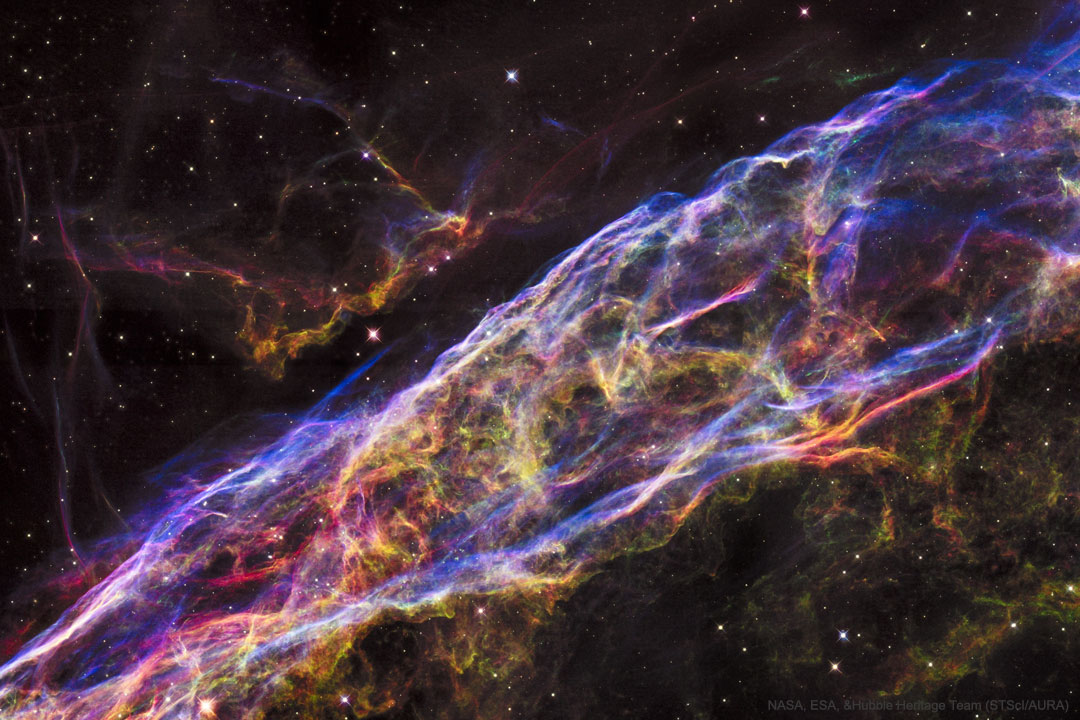
Image Credit: NASA, ESA, and the Hubble Heritage Team (STScI/AURA)
Explanation: Wisps like this are all that remain visible of a Milky Way star. About 7,000 years ago that star exploded in a supernova leaving the Veil Nebula. At the time, the expanding cloud was likely as bright as a crescent Moon, remaining visible for weeks to people living at the dawn of recorded history. Today, the resulting supernova remnant, also known as the Cygnus Loop, has faded and is now visible only through a small telescope directed toward theconstellation of the Swan (Cygnus). The remaining Veil Nebula is physically huge, however, and even though it lies about 1,400 light-years distant, it covers over five times the size of the full Moon. The featured picture is a Hubble Space Telescope mosaic of six images together covering a span of only about two light years, a small part of the expansive supernova remnant. In images of the complete Veil Nebula, even studious readers might not be able to identify the featured filaments.
2017-09-18
Astronomy picture of the day - 2017 September 18 - Orion above Easter Island
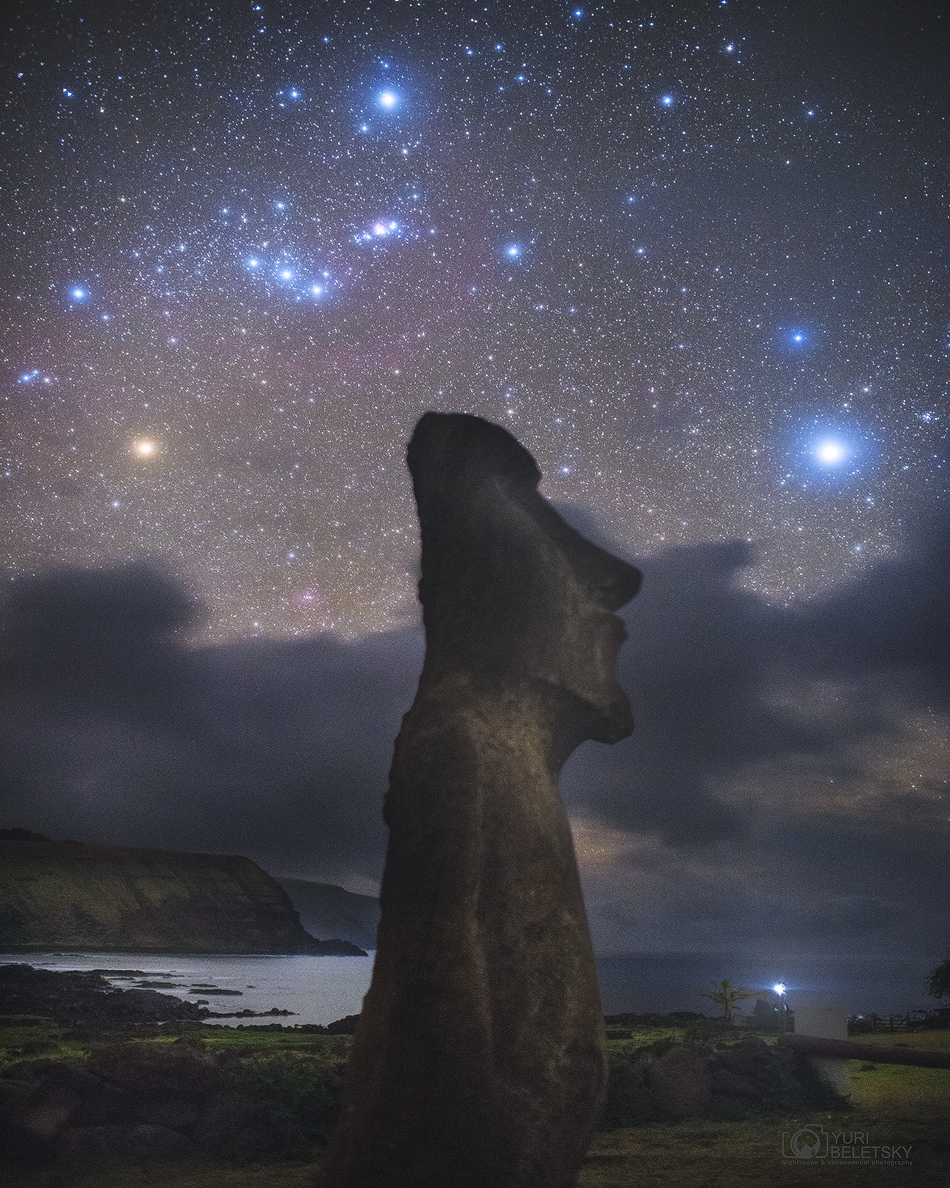
Image Credit & Copyright: Yuri Beletsky (Carnegie Las Campanas Observatory, TWAN)
Explanation: Why were the statues on Easter Island built? No one is sure. What is sure is that over 800 large stone statues exist there. The Easter Island statues, stand, on the average, over twice as tall as a person and have over 200 times as much mass. Few specifics are known about the history or meaning of the unusual rock sculptures, but many believe that they were created about 700 years ago in the images of local leaders of a lost civilization. Featured here, one of the ancient Moai sculptures was imaged in 2016 before the constellation of Orion, including the famous line of three belt stars and brilliant stars Betelgeuse (far left in red) and Rigel (upper center). The stone giant appears, however, to be inspecting the brightest star in the night sky (far right): Sirius.
2017-09-17
Astronomy picture of the day - 2017 September 17 - Bright Spiral Galaxy M81
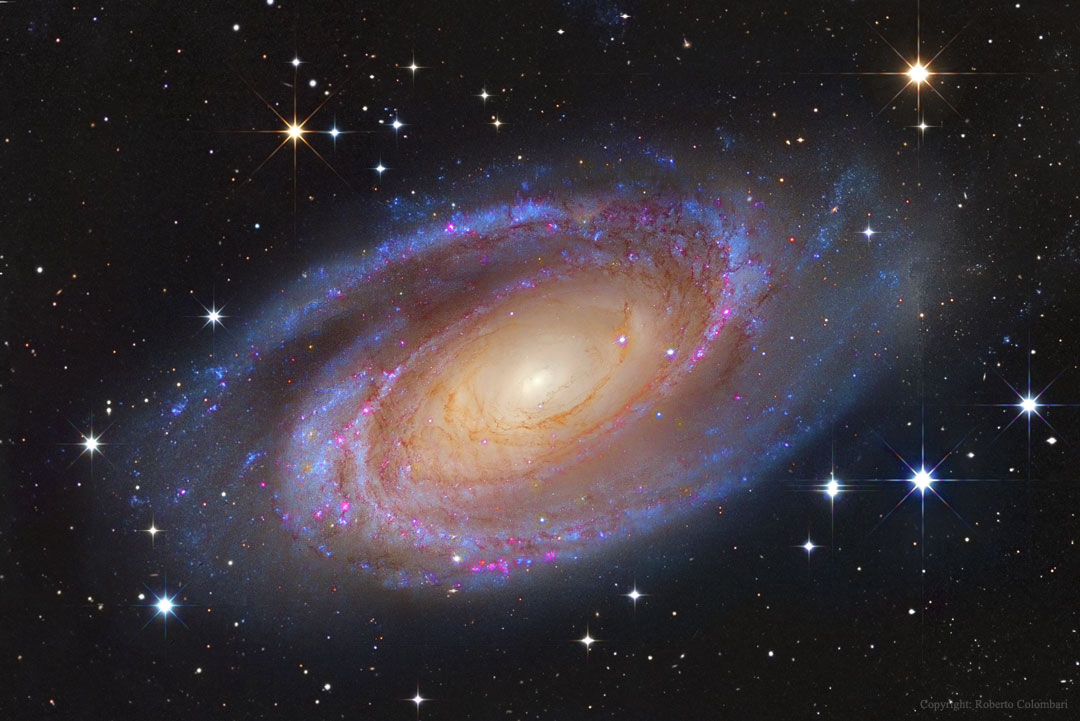
Image Credit: Subaru Telescope (NAOJ), Hubble Space Telescope;
Processing & Copyright: Roberto Colombari & Robert Gendler
Explanation: One of the brightest galaxies in planet Earth's sky is similar in size to our Milky Way Galaxy: big, beautiful M81. This grand spiral galaxy can be found toward the northern constellation of the Great Bear (Ursa Major). This superbly detailed view reveals M81's bright yellow nucleus, blue spiral arms, and sweeping cosmic dust lanes with a scale comparable to the Milky Way. Hinting at a disorderly past, a remarkable dust lane actually runs straight through the disk, to the left of the galactic center, contrary to M81's other prominent spiral features. The errant dust lane may be the lingering result of a close encounter between M81 and its smaller companion galaxy, M82. Scrutiny ofvariable stars in M81 has yielded one of the best determined distances for an external galaxy -- 11.8 million light-years.
2017-09-16
Astronomy picture of the day - 2017 September 16 - Cassini's Final Image
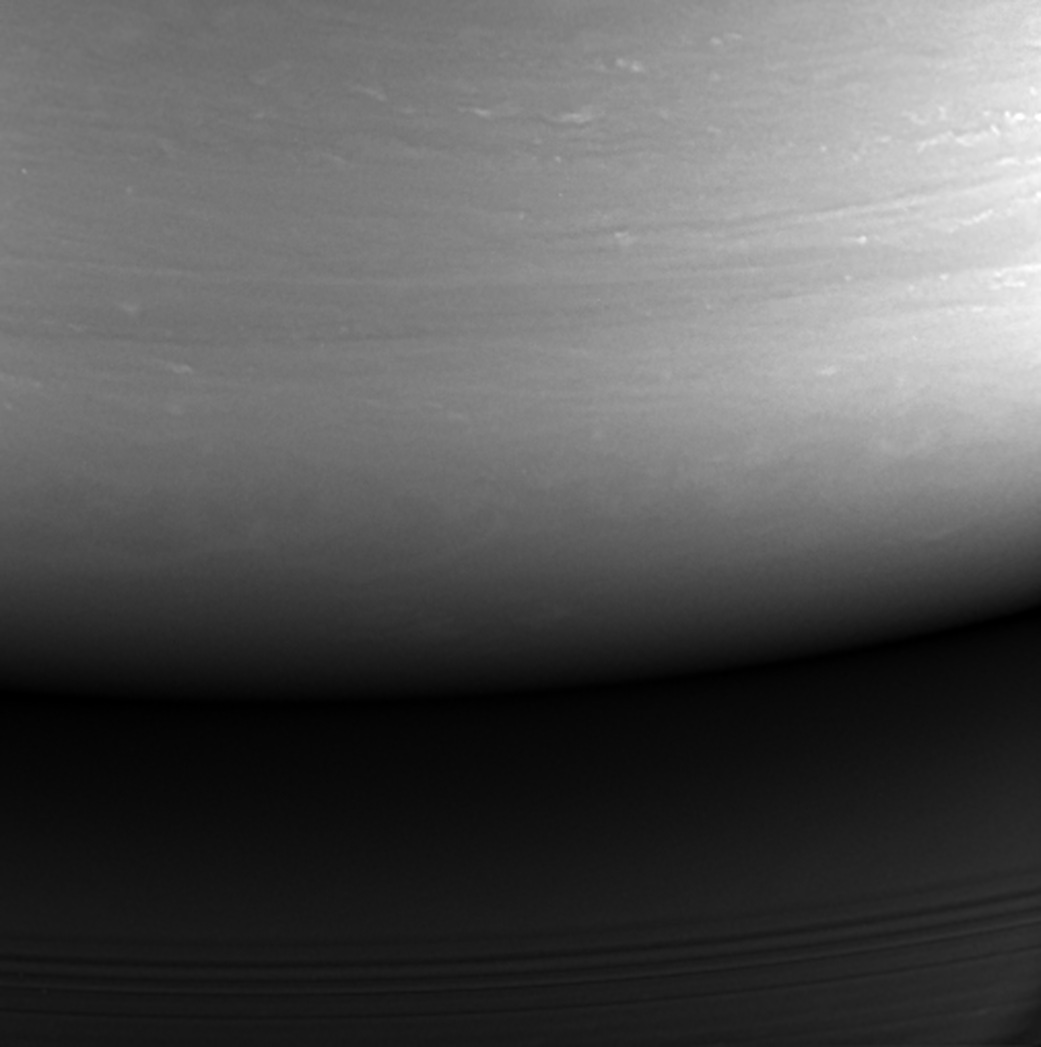
Image Credit: NASA, JPL-Caltech, Space Science Institute
Explanation: As planned, the Cassini spacecraft impacted the upper atmosphere of Saturn on September 15, after a 13 year long exploration of the Saturnian System. With spacecraft thrusters firing until the end, its atmospheric entry followed an unprecedented series of 22 Grand Finale dives between Saturn and rings. Cassini's final signal took 83 minutes to reach planet Earth and the Deep Space Network antenna complex in Canberra Australia where loss of contact with the spacecraft was recorded at 11:55 UT. For the spacecraft, Saturn was bright and the Sun was overhead as it plowed into the gas giant planet's swirling cloud tops at about 70,000 miles (113,000 kilometers) per hour. But Cassini's final image shows the impact site hours earlier and still on the planet's night side, the cloud tops illuminated by ringlight, sunlight reflected from Saturn's rings.
2017-09-15
Astronomy picture of the day - 2017 September 15 - 100 Steps Forward
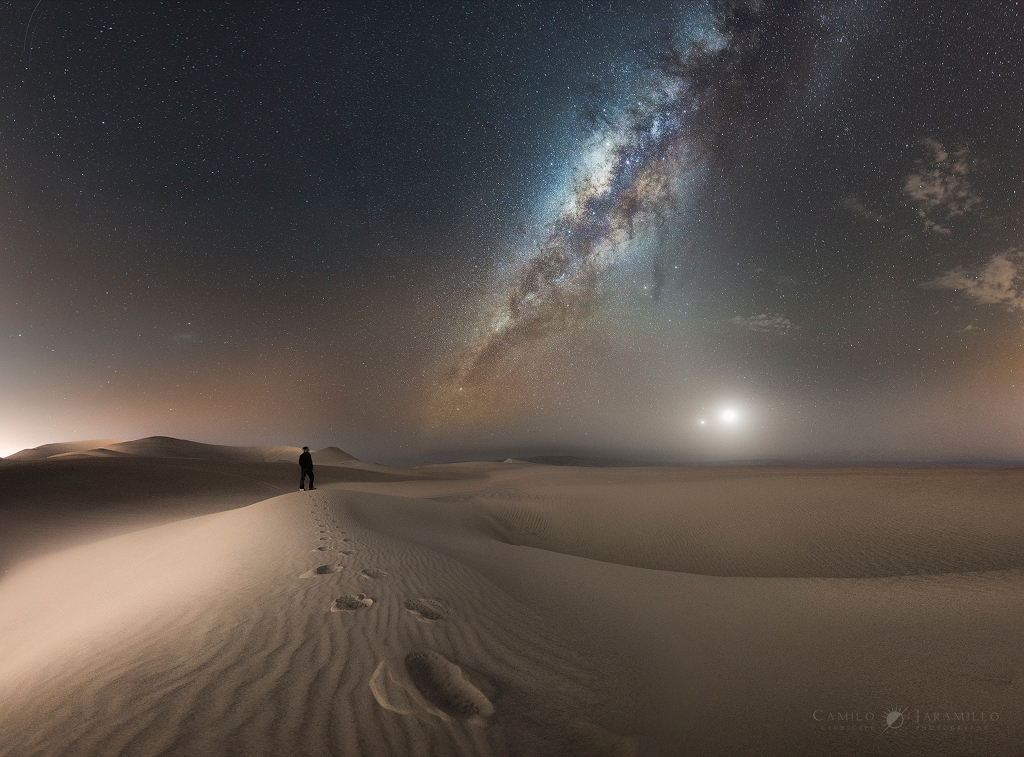
Image Credit & Copyright: Camilo Jaramillo
Explanation: A beautiful conjunction of Venus and Moon, human, sand, and Milky Way is depicted in this night skyscape from planet Earth. The scene is a panorama of 6 photos taken in a moment near the end of a journey. In the foreground, footsteps along the wind-rippled dunes are close to the Huacachina oasis in the southwestern desert of Peru. An engaging perspective on the world at night, the stunning final image was also chosen as a winner in The World at Night's 2017 International Earth and Sky Photo Contest.
2017-09-14
Expressões populares portuguesas : “Há mar e mar, há ir e voltar”
 Há frases que todos usamos que nasceram da publicidade. Alguns dos anúncios têm que se lhe diga, pois foram criados por grandes poetas. Basta lembrar o “Primeiro estranha-se, depois entranha-se” que Fernando Pessoa criou para a Coca-Cola quando estava ao serviço da agência Hora nos finais dos anos 20.
Há frases que todos usamos que nasceram da publicidade. Alguns dos anúncios têm que se lhe diga, pois foram criados por grandes poetas. Basta lembrar o “Primeiro estranha-se, depois entranha-se” que Fernando Pessoa criou para a Coca-Cola quando estava ao serviço da agência Hora nos finais dos anos 20.
Já o “Há mar e mar, há ir e voltar”, segundo Andreia Vale, foi criada porAlexandre O’Neill, um dos autores que mais expressões criou para o mundo publicitário, nos anos 60. O Instituto de Socorros a Náufragos estava preocupado com os afogamentos nas praias e decidiu lançar uma campanha de segurança. O poeta português ajudou e lançou esta frase, que agora é usada como alerta para diversas situações.
Mas a primeira ideia do poeta era outra, marcada pelo seu humor negro: “Passe um verão desafogado”, propôs ele, mas não foi aceite. Nem desta vez, nem com a proposta que mandou à marca de colchões Lusopuma: “Com colchões Lusopuma você dá duas que parecem uma”. E como não há duas sem três, a ironia de Alexandre O’Neill, que quase pôs em causa o seu trabalho no Jornal de Letras, ficou bem patente no slogan para o Metropolitano de Lisboa: “Vá de metro, Satanás”. Um criativo, como se vê.
Artigo - Portugal sobe ao 3° lugar do ranking FIFA
Portugal ascendeu à terceira posição do ranking da FIFA, cuja atualização foi divulgada esta quinta-feira pelo organismo que tutela o futebol mundial.
A equipa das quinas, com 1386 pontos, relegou a Argentina para o quarto lugar, numa classificação agora comandada pela Alemanha, que destronou o Brasil da liderança.
Segundo a Federação Portuguesa de Futebol, a Seleção Nacional ocupa o terceiro lugar do ranking FIFA pela quinta vez no seu historial, depois das atualizações de abril e maio de 2010, outubro de 2012 e abril de 2014.
Esta é a melhor classificação de Portugal desde abril de 2014.
Classificação dos 10 primeiros:
1. Alemanha, 1606 pontos
2. Brasil, 1590
3. Portugal, 1386
4. Argentina, 1325
5. Bélgica, 1265
6. Polónia, 1250
7. Suíça, 1210
8. França, 1208
9. Chile, 1195
10. Colômbia, 1191
A Bola - Portugal
Astronomy picture of the day - 2017 September 14 - Flare Well AR2673
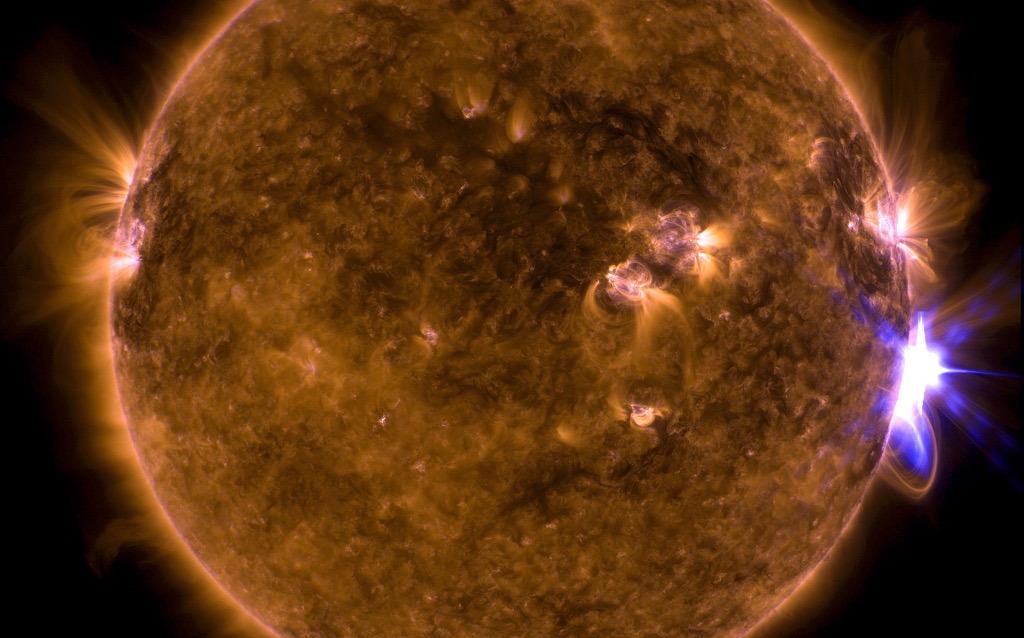
Image Credit: NASA, SDO, GSFC
Explanation: Almost out of view from our fair planet, rotating around the Sun's western edge giant active region AR2673 lashed out with another intense solar flare followed by a large coronal mass ejection on September 10. The flare itself is seen here at the right in an extreme ultraviolet image from the sun-staring Solar Dynamics Observatory. This intense flare was the fourth X-class flare from AR2673 this month. The active region's most recent associated coronal mass ejection collided with Earth's magnetosphere 2 days later. Say farewell to the mighty AR2673, for now. For the next two weeks, the powerful sunspot group will be on the Sun's far side.
2017-09-13
Astronomy picture of the day - 2017 September 13 - NGC 6334: The Cat's Paw Nebula
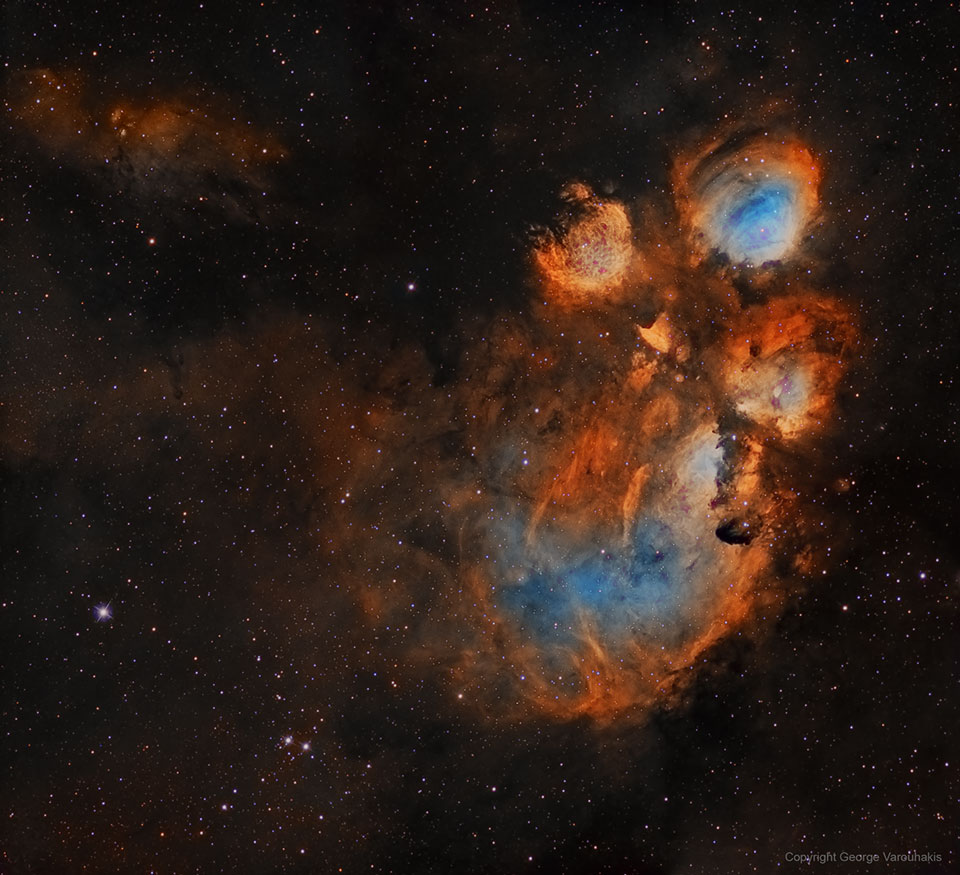
Image Credit & Copyright: George Varouhakis
Explanation: Nebulas are perhaps as famous for being identified with familiar shapes as perhaps cats are for getting into trouble. Still, no known cat could have created the vast Cat's Paw Nebula visible in Scorpius. At 5,500 light years distant, Cat's Paw is an emission nebula with a red color that originates from an abundance of ionized hydrogen atoms. Alternatively known as the Bear Claw Nebula or NGC 6334, stars nearly ten times the mass of our Sun have been born there in only the past few million years. Pictured here is a deep field image of the Cat's Paw Nebula in light emitted by hydrogen, oxygen, and sulfur.
2017-09-12
Astronomy picture of the day - 2017 September 12 - A Total Solar Eclipse Close-Up in Real Time
Video Credit & Copyright: Jun Ho Oh (KAIST, HuboLab);
Music: Flowing Air by Mattia Vlad Morleo
Explanation: How would you feel if the Sun disappeared? Many eclipse watchers across the USA surprised themselves with the awe that they felt and the exclamations that they made as the Sun momentarily disappeared behind the Moon. Perhaps expecting just a brief moment of dusk, the spectacle of unusually rapid darkness, breathtakingly bright glowing beads around the Moon's edge, shockingly pink solar prominences, and a strangely detailed coronastretching across the sky caught many a curmudgeon by surprise. Many of these attributes were captured in the featured real-time, three-minute video of last month's total solar eclipse. The video frames were acquired in Warm Springs,Oregon with equipment specifically designed by Jun Ho Oh to track a close-up of the Sun's periphery during eclipse. As the video ends, the Sun is seen being reborn on the other side of the Moon from where it departed.
2017-09-11
Imagens - Porto - Portugal (2)
O Porto foi eleito o melhor destino europeu de 2017, ficando à frente de Milão e de Gdansk, no pódio das três cidades mais votadas
Foto Pedro Granadeiro/global Imagens
Astronomy picture of the day - 2011 September 11 - X-Rays Indicate Star Ripped Up by Black Hole
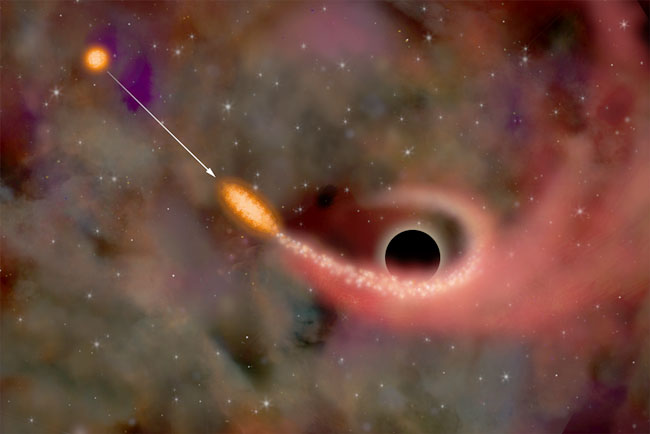
Illustration Credit: M. Weiss, CXC, NASA
Explanation: What could rip a star apart? A black hole. Giant black holes in just the right mass range would pull on the front of a closely passing star much more strongly than on the back. Such a strong tidal force would stretch out a star and likely cause some of the star's gasses to fall into the black hole. The infalling gas has been predicted to emit just the same blast of X-rays that have recently been seen in the center of galaxy RX J1242-11. Above, an artist's illustration depicts the sequence of destruction (assuming that image-distorting gravitational-lens effects of the black hole are somehow turned off). Most of the stellar remains would be flung out into the galaxy. Such events are rare, occurring perhaps only one in 10,000 years for typical black holes at the center of typical galaxies.
2017-09-10
Astronomy picture of the day - 2017 September 10 - Swirling Around the Eye of Hurricane Irma
Video Credit: NASA, GOES-16 Satellite, SPoRT
Explanation: Why does a hurricane have an eye at its center? No one is yet sure. What happens in and around a hurricane's eye is well documented, though. Warm air rises around the eye's edges, cools, swirls, and spreads out over the large storm, sinking primarily at the far edges. Inside the low-pressure eye, air also sinks and warms -- which causes evaporation, calm, and clearing -- sunlight might even stream through. Just at the eye's edge is a towering eyewall, the area of the highest winds. It is particularly dangerous to go outside when the tranquil eye passes over because you are soon to experience, again, the storm's violent eyewall. Featured is one of the most dramatic videos yet taken of an eye and rotating eyewall. The time-lapse video was taken from space by NASA's GOES-16 satellite last week over one of the most powerful tropical cyclones in recorded history: Hurricane Irma. Hurricanes can beextremely dangerous and their perils are not confined to the storm's center.
2017-09-09
Astronomy picture of the day - 2017 September 9 - Calm Waters and Geomagnetic Storm
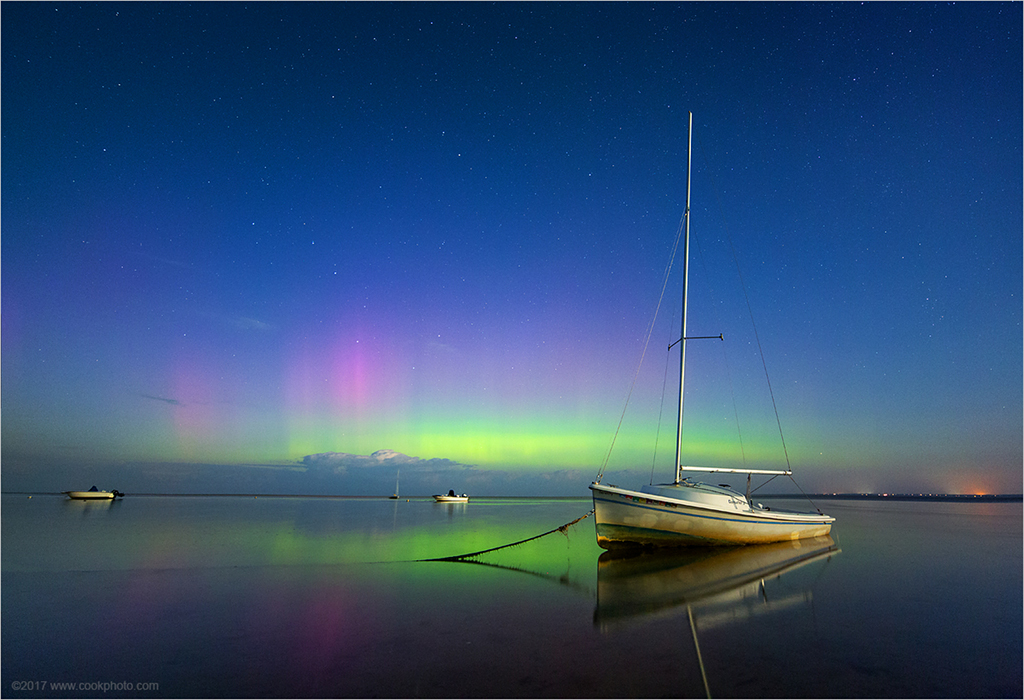
Image Credit & Copyright: Chris Cook
Explanation: Very recognizable stars of the northern sky are a backdrop for calm waters in this moonlit sea and skyscape off Cape Cod, Massachusetts. Taken on September 7, the photo also records a colorful display of northern lights or aurora borealis triggered by a severe geomagnetic storm. Visible crossing the Sun, the giant solar active region responsible, AR 2673, is much larger than planet Earth. It has produced the strongest flare of the current solar cycle and and the Earth-directed coronal mass ejection in the last few days.
2017-09-08
Imagens - Porto - Portugal
O Porto foi eleito o melhor destino europeu de 2017, ficando à frente de Milão e de Gdansk, no pódio das três cidades mais votadas
Foto Leonel De Castro/global Imagens
Astronomy picture of the day - 2017 September 8 - The Great Gig in the Sky
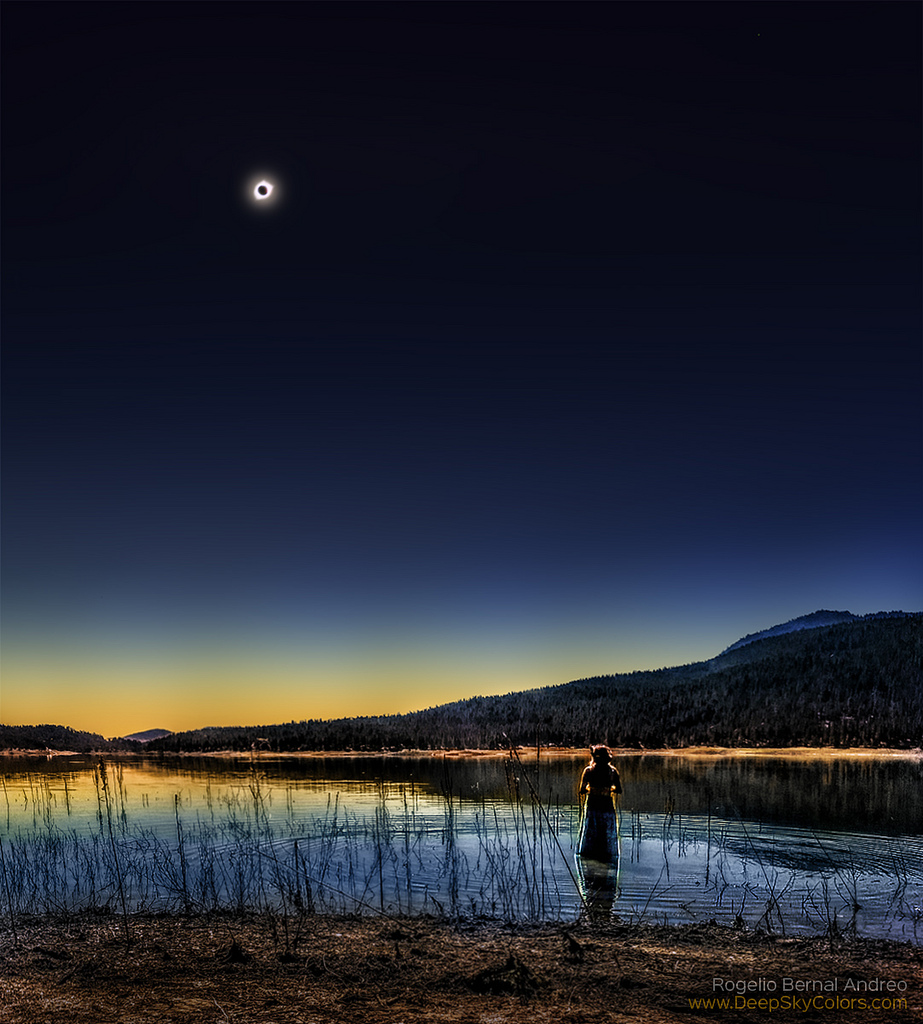
Image Credit & Copyright: Rogelio Bernal Andreo (Deep Sky Colors)
Explanation: There were no crowds on the beach at Phillips Lake, Oregon on August 21. But a few had come there to stand, for a moment, in the dark shadow of the Moon. From the beach, this unscripted mosaic photo records their much anticipated solar eclipse. In two vertical panels it catches the last few seconds of totality and the first instant of 3rd contact, just as the eclipse ends and sunlight faintly returns. Across the US those gathered along the path of totality also took pictures and shared their moment. And like those at Phillips Lake they may treasure the experience more than any planned or unplanned photograph of the total eclipse of the Sun.
2017-09-07
Astronomy picture of the day - 2017 September 7 - The Flash Spectrum of the Sun
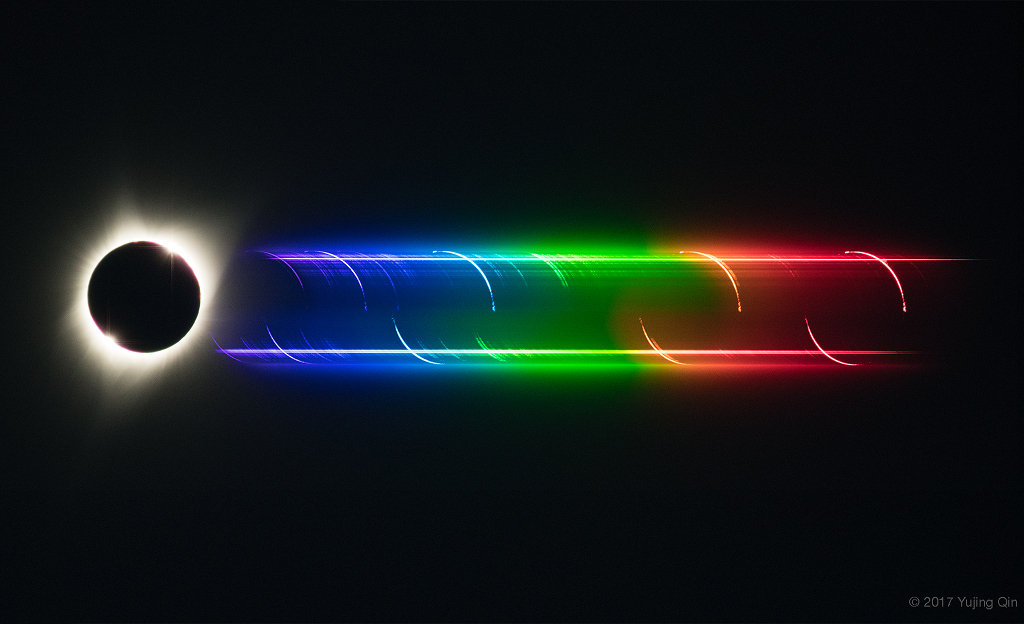
Image Credit & Copyright: Yujing Qin (University of Arizona)
Explanation: In clear Madras, Oregon skies, this colorful eclipse composite captured the elusive chromospheric or flash spectrum of the Sun. Only three exposures, made on August 21 with telephoto lens and diffraction grating, are aligned in the frame. Directly imaged at the far left, the Sun's diamond ring-like appearance at the beginning and end of totality brackets a silhouette of the lunar disk at maximum eclipse. Spread by the diffraction grating into the spectrum of colors toward the right, the Sun's photospheric spectrum traces the two continuous streaks. They correspond to the diamond ring glimpses of the Sun's normally overwhelming disk. But individual eclipse images also appear at each wavelength of light emitted by atoms along the thin, fleeting arcs of the solar chromosphere. The brightest images, or strongest chromospheric emission, are due to Hydrogen atoms. Red hydrogen alpha emission is at the far right with blue and purple hydrogen series emission to the left. In between, the brightest yellow emission is caused by atoms of Helium, an element only first discovered in the flash spectrum of the Sun.
2017-09-06
Astronomy picture of the day - 2017 September 6 - The Climber and the Eclipse
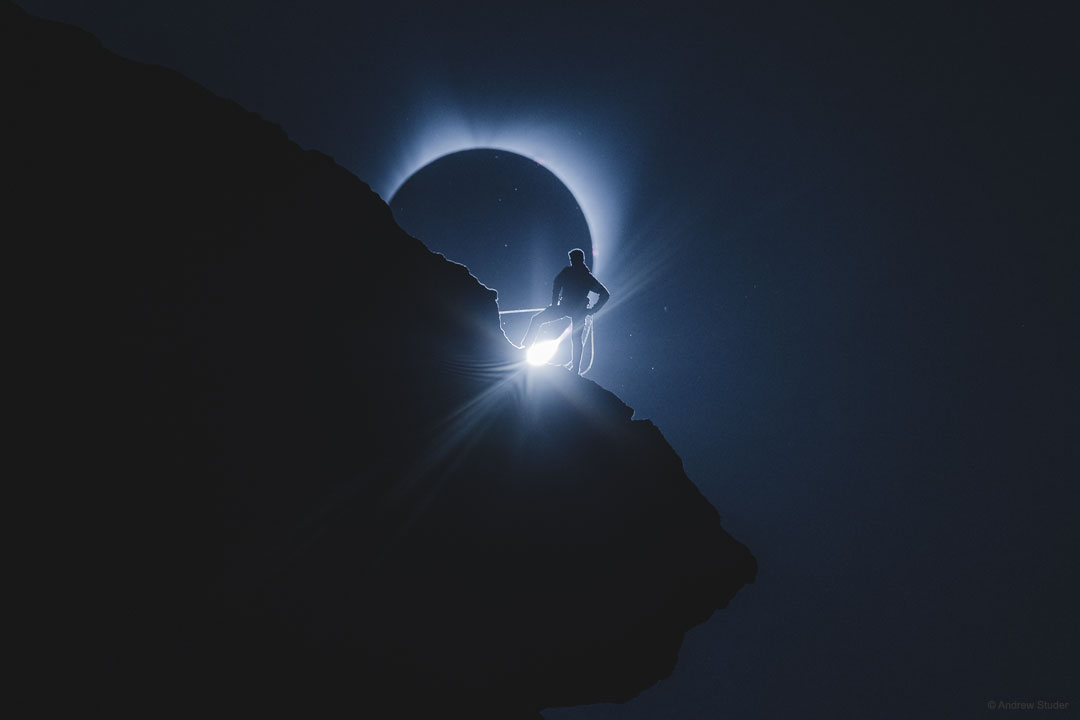
Image Credit & Copyright: Andrew Struder
Explanation: What should you do if your rock climbing picture is photobombed by a total eclipse of the Sun? Rejoice -- because your planning paid off. After months of considering different venues, and a week of scouting different locations in Oregon's Smith Rock State Park, a group of photographers and rock climbers led by Ted Hesser, Martina Tibell, and Michael Shainblum settled on picturesque 100-meter tall Monkey Face tower as the dramatic foreground for their images of the pending total solar eclipse. Tension mounted as the eclipse time approached, planned juxtapositions were scrutinized, and the placement of rock climber Tommy Smith was adjusted. Right on schedule, though, the Moon moved in front of the Sun, and Smith moved in front of the Moon, just as planned. The solar eclipse image displayed here actually shows a diamond ring, an eclipse phase when a bit of the distant Sun is still visible beyond the Moon's surface.
2017-09-05
Imagens do Mundo - Amanhecer em S. Sebastian - Espanha

Vista del amanecer en San Sebastián (España).JAVIER ETXEZARRETA EFE
Astronomy picture of the day - 2017 September 5 - Europa and Jupiter from Voyager 1
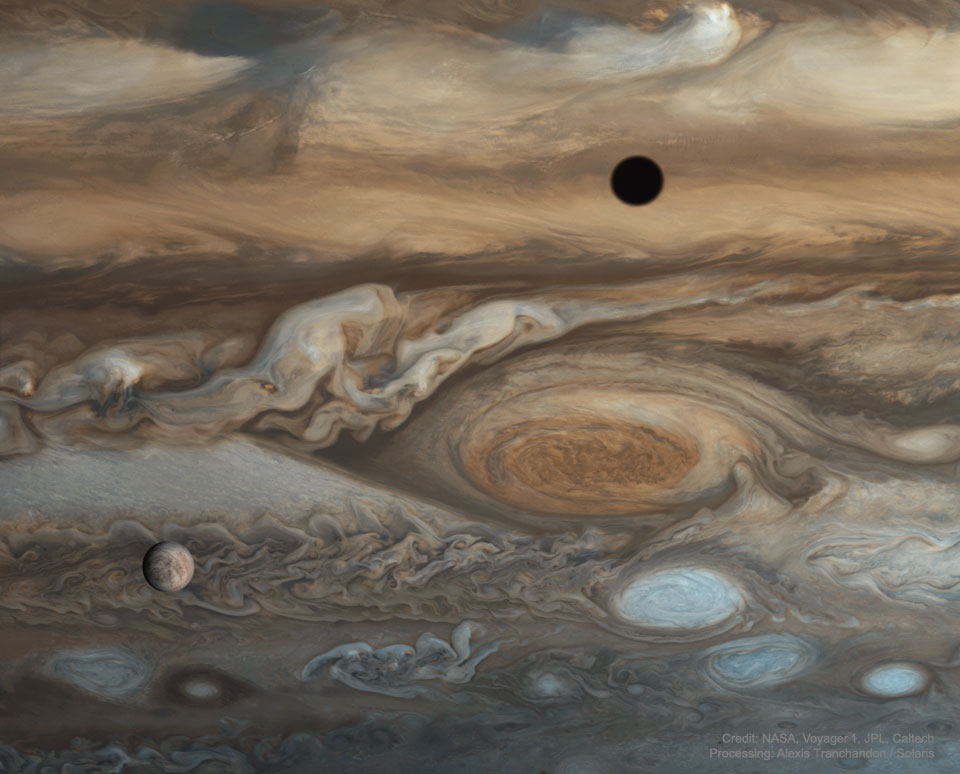
Image Credit: NASA, Voyager 1, JPL, Caltech; Processing & License: Alexis Tranchandon / Solaris
Explanation: What are those spots on Jupiter? Largest and furthest, just right of center, is the Great Red Spot -- a huge storm system that has been raging on Jupiter possibly since Giovanni Cassini's likely notation of it 352 years ago. It is not yet known why this Great Spot is red. The spot toward the lower left is one of Jupiter's largest moons: Europa. Images from Voyager in 1979 bolster the modern hypothesis that Europa has an underground ocean and is therefore a good place to look for extraterrestrial life. But what about the dark spot on the upper right? That is a shadow of another of Jupiter's large moons: Io. Voyager 1 discovered Io to be so volcanic that no impact craters could be found. Sixteen frames from Voyager 1's flyby of Jupiter in 1979 were recently reprocessed and merged to create the featured image. Forty years ago today, Voyager 1 launched from Earth and started one of the greatest explorations of the Solar System ever.
2017-09-04
Artigo - Banguecoque foi fundada por Portugueses e quer dizer Azeitão

Os thais chamam à sua capital Krung Thep Mahanakhon (กรุงเทพมหานคร), pelo que se o caro leitor se referir a Bangkok (Banguecoque grafado em português) em frente de um tailandês comum, este não compreenderá de que lugar se está a falar. Isto tem uma explicação. Bangkok foi criada por portugueses em meados do século XVII e, traduzido para português, quer dizer tão só Azeitão ou "aldeia das oliveiras" (Ban = aldeia + Kók/กอก = oliveira). Originárias da América do Sul, as spondias mombin (cajá-manga para os brasileiros) foram introduzidas no Sudeste-Asiático pelos portugueses em inícios do século XVII e usadas como base para molhos e conservas, ou seja, com a mesma finalidade do azeite de oliveira na Europa da Antiguidade e Idade Média. A aldeia de Bangkok nasceu no actual distrito de Samsen, três quilómetros a norte do complexo religioso-administrativo do palácio real, que só seria erigido a partir de 1782. Ali havia uma igreja em madeira que servia o Padroado e era em Bangkok que as embarcações que subiam o Chao Phrya (rio de Bangkok) em direcção à antiga capital (Ayutthaya), interrompiam a sua viagem para receberem pilotos experimentados na navegação fluvial. Estes pilotos eram luso-siameses católicos, os únicos siameses que falavam a língua franca comercial e diplomática da região entre os séculos XVI e XIX, a língua portuguesa.
Miguel Castelo Branco
Alentejo - Teresa Silva Carvalho - "O rama o que linda rama" - Video - Musica

"O rama o que linda rama"
Astronomy picture of the day - 2017 September 4 - Saturn's Rings from the Inside Out
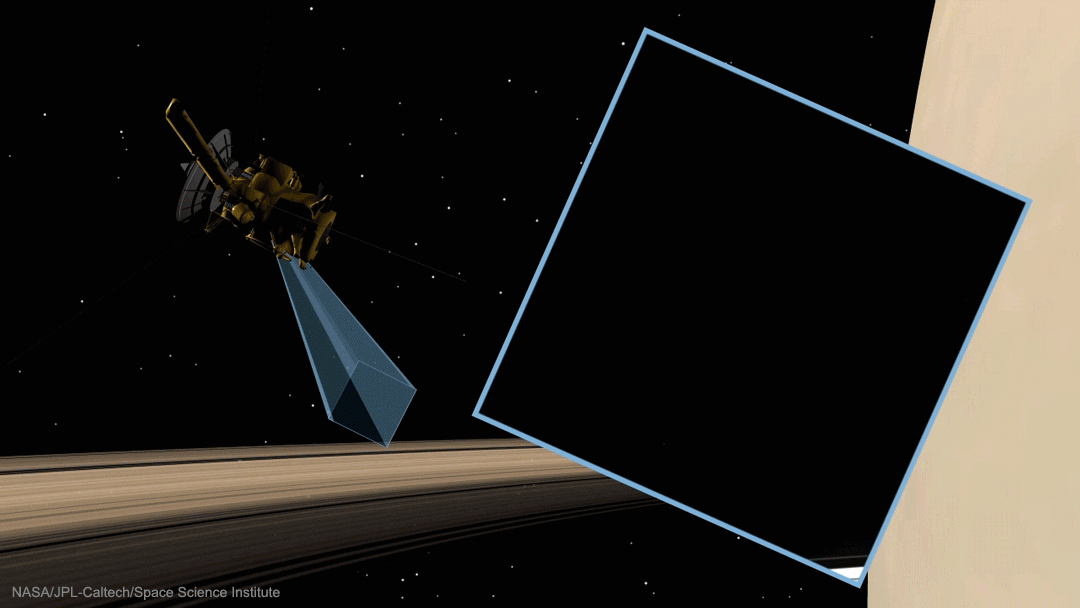
Video Credit: NASA, JPL-Caltech, Space Science Institute
Explanation: What do Saturn's rings look like from Saturn? Images from the robotic spacecraft Cassini are providing humanity with this unprecedented vantage point as it nears the completion of its mission. Previous to Cassini's Grand Finale orbits, all images of Saturn's majestic ring system were taken from outside of the rings looking in. Pictured in the inset is the remarkable video, while the spacecraft's positions are depicted in the surrounding animation. Details of the complex rings are evident as the short time-lapse sequence begins, while the paper-thin thickness of the rings becomes apparent near the video's end. The featured images were taken on August 20. Cassini has only a few moreorbits around Saturn left before it is directed to dive into the giant planet on September 15.
2017-09-03
Astronomy picture of the day - 2017 September 3 - A Waterspout in Florida
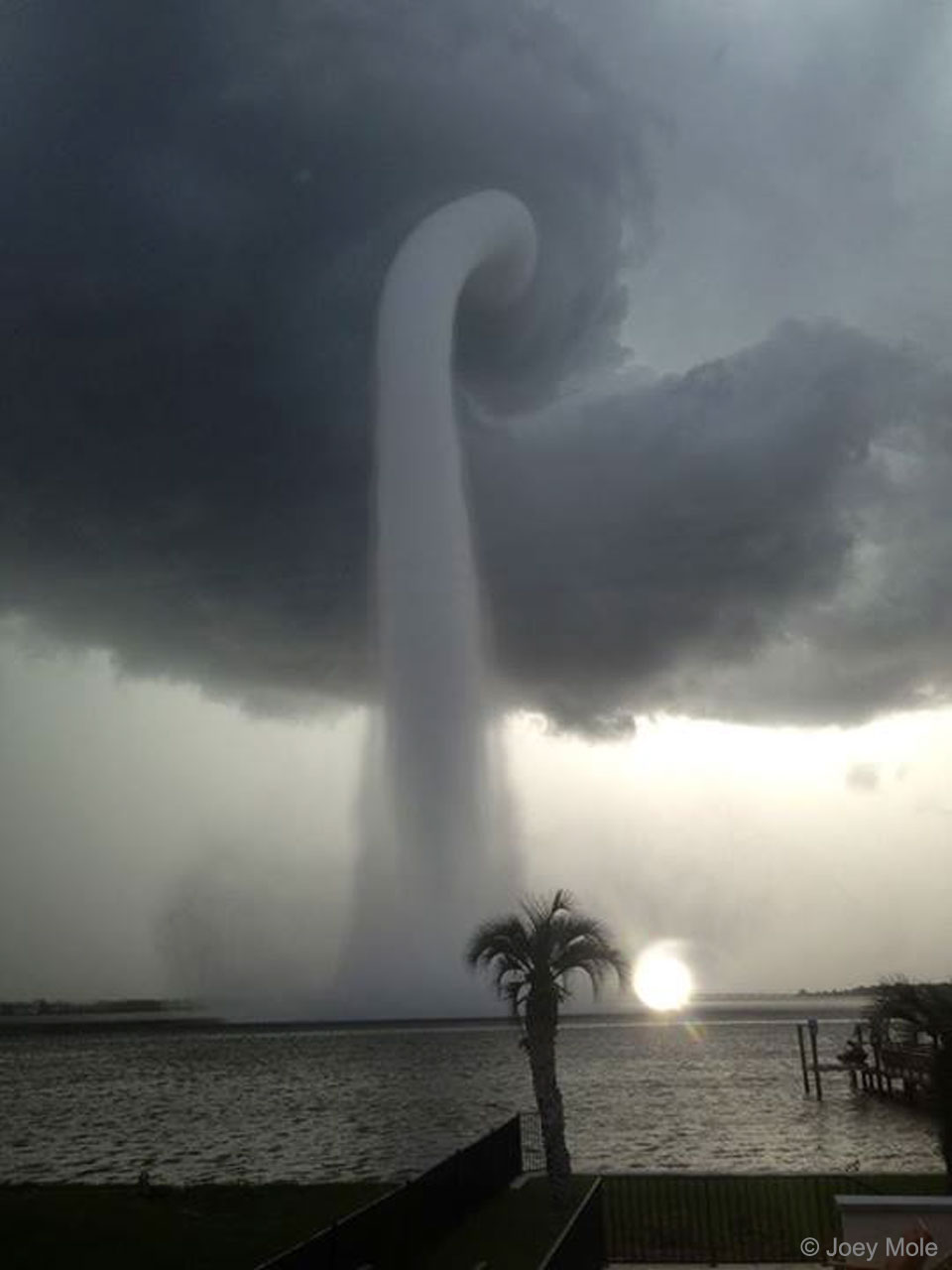
Image Credit & Copyright: Joey Mole
Explanation: What's happening over the water? Pictured here is one of the better images yet recorded of a waterspout, a type of tornado that occurs over water. Waterspouts are spinning columns of rising moist air that typically form over warm water. Waterspouts can be as dangerous as tornadoes and can feature wind speeds over 200 kilometers per hour. Some waterspouts form away from thunderstorms and even during relatively fair weather. Waterspouts may be relatively transparent and initially visible only by an unusual pattern they create on the water. The featured image was taken in 2013 July near Tampa Bay, Florida. The Atlantic Ocean off the coast of Florida is arguably the most active area in the world for waterspouts, with hundreds forming each year. Some people speculate that waterspouts are responsible for some of the losses recorded in the Bermuda Triangle.
2017-09-02
Expressões populares portuguesas - Nem disse água vai nem água vem

É uma das expressões que entrou na boca dos portugueses depois do terramoto de 1755, explica Andreia Vale. Quando Sebastião José de Carvalho e Melo – o Marquês de Pombal – ficou responsável pela reconstrução da capital após o abalo, decidiu que ia implementar um sistema de esgotos.
Na altura foi uma revolução… e uma esperança na higiene da cidade. É que até aquele momento, a água suja de casa (sim, essa que inclui até mesmo as da casa de banho) eram atiradas pela janela para a rua. Diziam as empregadas “Água vai!” e toda a gente sabia que o melhor era sair das proximidades.
A expressão “Nem disse água vai, nem água vem” surgia sempre que alguém fazia algum desses despejos sem avisar. E ficou para exemplificar exatamente a ideia de que alguém não fez o devido alerta ou aviso do que devia.
Inscription à :
Commentaires (Atom)
